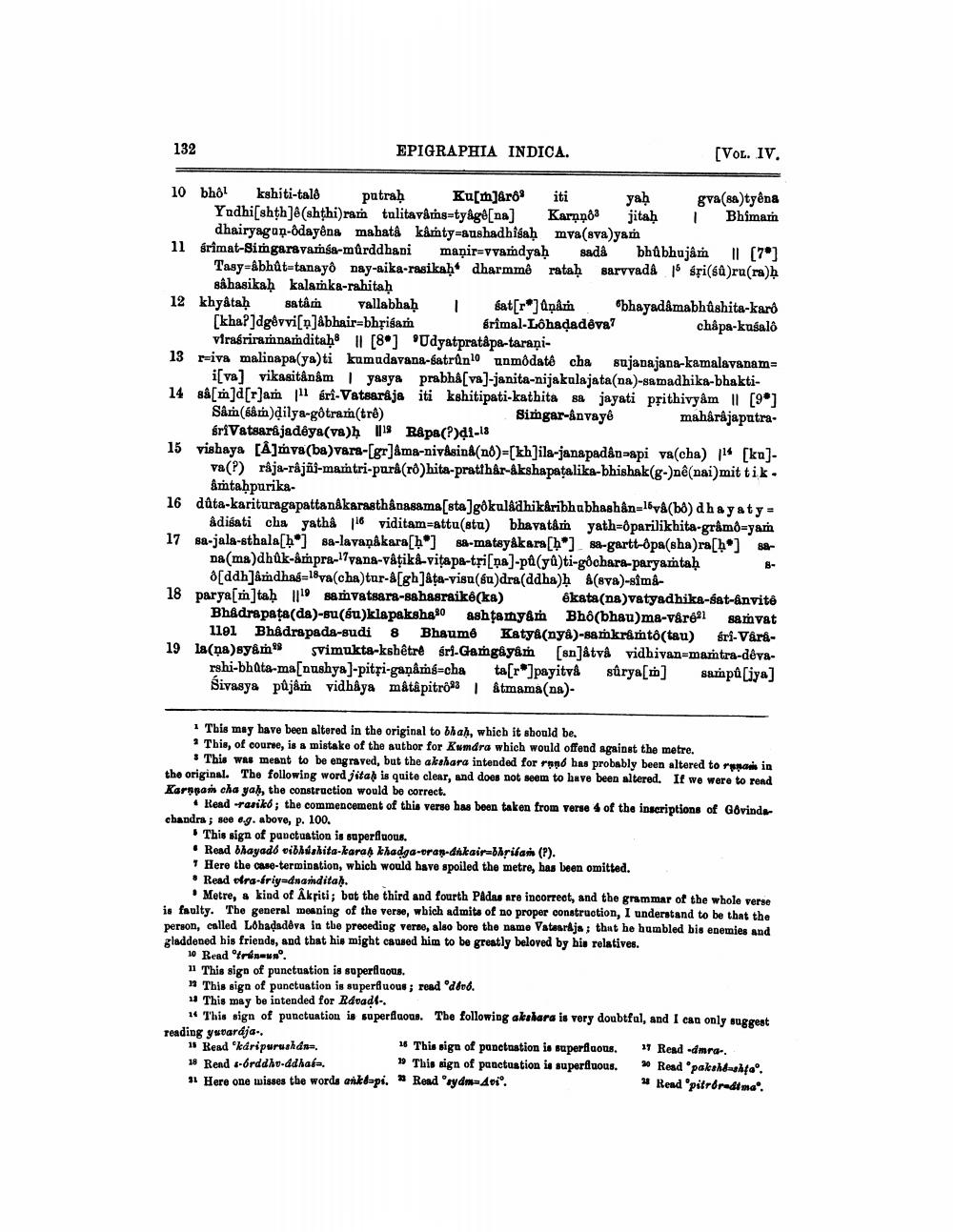________________
132
EPIGRAPHIA INDICA.
(VOL. IV.
10 bhô kshiti-tald putraḥ Ku[m]ård iti yaḥ gva(sa)tyena
Yudhi[shth]ë (shthi)ram tulitavams=tyage[na] Karano jitah i Bhimam
dhairyagun-ôdayêna mabatâ kâmty=aushadhigaḥ mva(sva)yam 11 srimat-Simgaravamsa-murddhani mapir=vvamdyaḥ sadá bhûbhujâm [7"]
Tasy-abhůt=tanayo nay-aika-rasikah* dharmmê rataḥ sarvvada 16 sri(s)ru(ra)h
sâhasikaḥ kalamka-rahitaḥ 12 khyâtaḥ satâm vallabhaḥ sat[r] Qņâm bhayadâmabhûshita-karo [kha?]dgêvvi[7]abhair-bhrisam erîmal-Lôhadadêva7
chåpa-kušalo virasriramnamditaḥ ll [8] Udyatpratậpa-tarani13 ruiva malinapa(ya)ti kumudavana-satran lo unmodato cha sujanajana-kamalavanam
i[va] vikasitânâm y asya prabhå[va)-janita-nijakalajata(na)-samadhika-bhakti14 sâ[m]d[r]am | sri-Vatsaraja iti kshitipati-kathita sa jayati prithivyâm || [98] Sân(6ân)dily8-gotran(trê) .
Simgar-anvayê mahårâjaputrasri Vatsarajadhya(va)h 18 R&pa(?)41-18 15 vishaya Arya (ba)Vara-[gr]Ama-nivåsin(n)-[kh]ila-janapadanaspi va(cha) 114 [ku].
va(?) råja-rajñi-mamtri-parâ(rð)hita-pratthår-akshapatalika-bhishak(g- nê(naimit tik.
åmtahpurika16 dûta-karituragapattanákarasthanasama[eta]gôkulAdhikaribhubhashân=lv&(bo) dhayaty
adišati cha yatha 16 viditam-attu(stu) bhavatâm yath-parilikhita-gråmô=yam 17 sa-jala-sthala[h*] sa-lavaņåkara[ho] sa-matsyåkara[h*] sa-gartt-opa(sha)ra[ho] 88
Da(ma)dhük-åmpra-17vana-vâţikd-vitapa-tri[a]-pů (yů)ti-gôchara-paryamtaḥ
8[ddhjämdhag=18va(cha)tar-& [gb]åta-visa (su)dra(ddha)” (sva)-sim18 parya[m]taḥ 119 samvatsara-sahasraikė(ka) ekata(na)vatyadhika-sat-ânvité
Bhadrapata(da)-su(gu)klapaksha ashtamyam Bho(bhau)ma-varol samvat
llel Bhadrapada-eudi 8 Bhaumé Katya(nya)-samkramtô(tau) Sri-Vård19 la(na)sylmo svimukta-ksbêtre sri-Gamgayam [sn]åtvå vidhivan-mantra-deva
rshi-bhdta-ma[nushya)-pitfi-ganáms=cha ta[ro]payitvå sûrya[m] sampû siya] Sivasya půjâm vidhåya måtâpitrô83 &tmama(na)
* This may have been altered in the original to bhah, which it should be. 1 This, of course, is a mistake of the author for Kumara which would offend against the metre.
* This was meant to be engraved, but the akshara intended for rond has probably been altered to an in the original. The following word jital is quite clear, and does not seem to have been altered. If we were to read Karapan cha yah, the construction would be correct.
Read -rasiko; the commencement of this verso has been taken from verse of the inscriptions of Govinde chandra; see og. above, p. 100.
This sign of ponctuation is superfluous. • Read bhayadó vibhialita-karam khadga-erap.dokair-bhrilan (P). * Here the case-termination, which would have spoiled the metre, has been omitted. • Read ofra-friyadnandita).
• Metre, a kind of Akriti; but the third and fourth Padas are incorrect, and the grammar of the whole verse is faulty. The general meaning of the verse, which admits of no proper construction, I understand to be that the person, called Lobadadôva in the preceding verse, also bore the name Vataardja; that he humbled bis enemies and zladdened his friends, and that his might caused him to be greatly beloved by his relatives.
10 Read trineus. 11 This sign of punctuation is superfluous.
This sign of punctuation is superfluous; road odbró.
This may be intended for Rdvadt. ** This sign of punctuation is superfluous. The following aksara is very doubtfal, and I can only suggest reading ystardja.. 1 Read "karipuruskans.
* This sign of panctuation is superfluous. * Read .dmra. 18 Rend s-Orddhu.ddhasa,
19 This sign of panctuation is superfluous. * Read 'pakahdustao. 31 Here one wisses the words anklapi. – Read ydm-40°.
# Read 'pitroreditma'.




